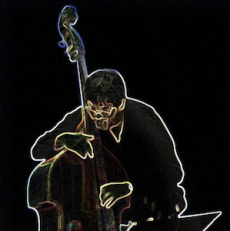
Daily Dose Of Jazz…
Jan Gunnar Hoff was born in Bodø, Norway on October 22, 1958. A graduate of the Teachers’ College in his hometown and Bergen, Norway, he pursued further education in the Jazz program at Trondheim Musikkonservatorium under Terje Bjørklund for three years starting in 1986. He trained in composition at Norges Musikkhøgskole in 2001.
He had his jazz debut with his own trio on Ad Lib Jazzklubb in 1976. Hoff’s background includes classical piano, progressive rock, pop and jazz. Over the course of his career Hoff has released 21 recordings as solo artist and co-leader, fifty-seven as a sideman, and has composed 250 works for different settings.
He has received several awards for his music including a US Grammy nomination for the album Quiet Winter Night. Hoff’s quartet album Fly North with Marilyn Mazur, Anders Jormin and Arve Henriksen was nominated for the Norwegian Grammy, Spellemannpris 2014. He received the highest distinction in Norwegian Jazz, the Buddy-award and became a Steinway Artist.
He is a professor at the University of Tromsø and the University of Agder. He co-founded The Groove Valley JazzCamp in Beiarn, Norway and was artistic director for TGV Jazz camp from 2005 to 2009. Hoff also initiated Bodø Jazz Open which was launched in 2011, where he was artistic leader and festival head until 2020.
Pianist, composer, arranger and professor Jan Hoff, who has worked with Pat Metheny, Mike Stern, Alex Acuña, Karin Krog, Maria João, Marilyn Mazur, Gary Novak and Arild Andersen among numerous others.
More Posts: arranger,bandleader,composer,educator,history,instrumental,jazz,music,piano

Daily Dose Of Jazz…
Linda Presgrave was born in St. Louis, Missouri on October 12, 1951. During her hometown years she performed as a leader with her group, After Six Jazz, at the finest jazz venues in St. Louis. At the same time she worked with the Sessions Big Band, the Modern Vintage Jazz Quartet and the Kim Portnoy Jazz Orchestra. As a former professional French Horn player, she performed regularly at the Muny, Fox and Riverport theaters in orchestral settings behind top entertainers, world class ballet ensembles and national theatrical productions.
Relocating to New York City in 1998 she left a very active music career in her native city for the vibrant jazz scene of a new city. Since moving Linda has released four compact discs on the Metropolitan Records label. She continues on a mission to bring attention to compositions by inspirational jazz artists who happen to be women.
Linda has performed on prestigious jazz festival stages in America and a few in Europe. When not performing with her own group she sits in the piano chair of Carol Sudhalter’s Astoria Big Band and also with a new group, Ladies Day, led by MJ Territo that features music and lyrics by women.
Linda Pianist, composer and arranger Linda Presgrave continues to perform, record and tour.
More Posts: bandleader,history,instrumental,jazz,music,piano

Daily Dose Of Jazz…
Manny Flores Jr. was born in El Paso, Texas on October 9, 1954. He spent his first eighteen years of life as an army brat, traveling and listening to music in a variety of different places. He began his playing career in the summer of 1971 at a gig at the Fort Huachuca NCO Club. At this time his inspiration for the bass was fellow left-handed bass player Paul McCartney. Graduating from Buena High School in Sierra Vista, Arizona in l972.
He also listened to jazz when he would buy Blue Note LPs at the bargain bin with Eric Dolphy and Charles Mingus among his favorites. He then graduated from Cochise College in Douglas, Arizona in 1974 with an Associates degree in Liberal Arts. By 1975 he was back in his hometown of El Paso and began playing in various groups including Top 40 and Country/Western groups in New Mexico, Wyoming and Arizona. Enrolling at the University of Texas at El Paso, he received his Bachelor of Music Education degree in 1982.
In 1983 he auditioned for and began playing with the El Paso Symphony Orchestra under the direction of Maestro Abraham Chavez Jr. He also began teaching instrumental music in the Ysleta Independent School District. During the decade Manny met many musicans who inspired him to make music a way of life including Frank Zappa, Jaco Pastorius, Ray Brown and Julliard cello teacher Harvey Shapiro.
In 1985 he began the first of a four-year trek to Victoria, British Columbia, Canada to attend the prestigious Johannesen International School of the Arts. He attended six-week master classes, and spent a summer in New York City studying jazz and listening to live performances of Charlie Haden, Marc Johnson, Harvie Swartz, and Eddie Gomez.
Flores has played with several big bands in addition to Bobby Saunders, Frank Dove and the Sundowners, Mario Otero, Crossroads, El Paso Brass Quintet, Bobby Booth Dixieland Band, M.D. Quartet, U.T.E.P. Lab Band I with Gene Lewis, Mike Francis Quartet, Gerald Hunter and the Quintones, Art Lewis and the Earthmen, Orchestra Puerto Rico, Spice of Life, Bing Browning Trio, Cecile Larochelle, The Platters, The Four Lads, The Four Aces, Jimmy Dorsey Orchestra, Mel Carter, Roger Miller, Johnny Mathis, Guy Lombardo’s Royal Canadians, Charlie Rouse and Boyz II Men.
By 1998 he made his first trip to Rio de Janeiro, Brazil to fulfill a lifelong desire to experience Brasilian music firsthand and to meet one of his favorite musicans Hermeto Pascoal. He hung out with his friends Albert Suhett, Itibere Zwarg, Marcio Bahia, and Hermeto. Marcio Bahia introduced him to bassist Adriano Giffoni with whom he studied with each summer in Rio.
Bassist Manny Flores Jr. is involved in the Universal Music movement and continues to perform locally in Austin and El Paso.
More Posts: bass,history,instrumental,jazz,music

Daily Dose Of Jazz…
Chris Abelen was born in Tilburg, Netherlands on September 29, 1959 and started out on trumpet at 11, switching to the bigger horn at 18. He studied classical trombone with Charles Toet and Henri Aarts, and then jazz and improvised music with Willem van Manen a member of Willem Breuker Kollektief, the band that first called global attention to Dutch improvised music.
Taking over van Manen’s chair in the Kollektief in 1984, they would tour and record extensively with that band until 1988. Abelen led his own groups and in 1992 led a pan-generational, pan-stylistic international tentet showcasing the players with mini-concertos that demonstrate Abelen’s preoccupations with color, texture, mood, and his wry indirect sense of humor.
His desire to lead his own band had him forming first a sextet that evolved into a quartet. He then put together a tentet, in which a quartet and quintet was produced. All the configurations went on to record several albums. Over the years Chris has toured and recorded with numerous Dutch jazz and new music ensembles, including Willem van Manen’s Contraband, I Compani, Paradise Regained Orchestra, Eric van der Westen Octet, and numerous others.
Taking his music in a new direction by 2016 he had released his sixth album, A Day At The Office, with a septet. Other new projects are still in the pipeline and trombonist Chris Abelen continues to perform and compose.
More Posts: bandleader,history,instrumental,jazz,music,trombone

Daily Dose Of Jazz…
Robert Falk was born in Paris, France on September 22, 1953 but soon moved to Brussels, Belgium where he studied guitar at the Université Libre de Bruxelles. He started playing folk-music, then jazz-rock before getting interested in computer-aided musical composition.
He played in several bands in the 80’s such as Spring with Michel Delory and François Garny, and Falklands with Alain Rochette and Sam Mc Kinney. In 1989 he visited Zaire giving him the opportunity to get acquainted with African music.
He became active as a producer-arranger for various African artists in the Nineties and has produced Embowassa, Dominic Kakolobango, Malick Pathé Sow & Welnere, and early in the new century Diariyata and Pas Mal +.
He recorded and released his debut album Muzungu as a leader in 2006 featuring his afro-jazz compositions. Mixing intello jazz with african rythms that mainly come from the Congo, Rwanda and Burundi.
His sophomore project is afro-jazz centered around West~African music but includes Brazilian influences as in a congolese samba. It is titled Xelu Sowu, which translates to The Spirit of the West in wolof.
Guitarist and composer Robert Falk continues to perform and record.
More Posts: bandleader,composer,guitar,history,instrumental,jazz,music



